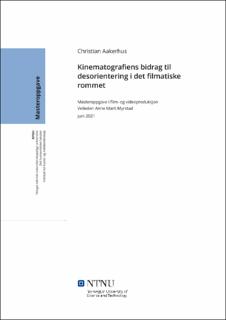| dc.contributor.advisor | Myrstad, Anne Marit | |
| dc.contributor.author | Aakerhus, Christian | |
| dc.date.accessioned | 2021-09-14T16:16:45Z | |
| dc.date.available | 2021-09-14T16:16:45Z | |
| dc.date.issued | 2021 | |
| dc.identifier | no.ntnu:inspera:76652620:22535156 | |
| dc.identifier.uri | https://hdl.handle.net/11250/2776709 | |
| dc.description.abstract | Denne masteroppgaven undersøker hvordan kinematografi er med på å bidra til et følelsesmessig engasjement ved å bruke grep som bidrar til desorientering og mangel på oversikt i det filmatiske rommet. Oppgaven ser på hvordan kinematografi bidrar til et følelsesmessig engasjement ved å analysere to grøsserfilmer hvor den ene filmen er indiefilmen The Blair Witch Project og den andre er blockbusteren The Conjuring.
Oppgaven tar i bruk kinematografiske grep for å se hvordan filmene på hver sin måte bruker kinematografi til å formidle en opplevelse av desorientering. The Conjuring som en konvensjonell grøsserfilm og The Blair Witch Project som en pseudodokumentar gir grunnlaget for at filmene har meget forskjellige måter å benytte kinematografi på. Oppgaven ser med dette på hvordan begge filmene benytter kinematografien for å bidra til desorientering i det filmatiske rommet. Kinematografien blir også diskutert opp imot kontinuitetsklipping og treaktsstruktur.
Begge filmene har til felles at kinematografien motiveres av kaos. Kinematografien i The Blair Witch Project bryter med etablerte retningslinjer for film og oppleves som en mer uforutsigbar filmopplevelse kontra The Conjuring som er mer forutsigbar i kinematografi og fortellerform. The Blair Witch Project motiveres av kaos med en subjektiv kinematografi hvor kameraet er plassert i samme filmunivers som skuespillerne. The Conjuring motiveres av kaos med en objektiv kinematografi som observerer skuespillerne i kaotiske sekvenser. | |
| dc.description.abstract | My master's thesis looks into how two horror films approach the use of cinematography to accentuate the feeling of disorientation. The choosen horror films for analysis are the blockbuster The Conjuring and the indiefilm The Blair Witch Project. The thesis discusses how two horror films, as different as these, uses cinematography in company with the three-act structure and continuity editing to emphasize disorientation.
The thesis employs cinematic terms to examine how each film uses cinematography to accentuate the feeling of disorientation. The Conjuring as a modern Hollywood film and The Blair Witch Project as a pseudodocumentary gives a baseline for both films to employ their cinematography in different ways. The cinematography will also be discussed in conjunction with continuity editing and the three-act structure.
Both films have in common that their cinematography are based around chaos. The cinematography in The Blair Witch Project breaks with the established storytelling techniques and is thus rendered as a unpredictable narrative. The Conjuring on the other hand uses an established form for both cinematography and storytelling. The Blair Witch Project is motivated by chaos with a subjective cinematography where the camera is placed within the same universe as the actors. The Conjuring is motivated by chaos with a objective form of cinematography where the camera observes the actors during chaotic encounters. | |
| dc.language | nob | |
| dc.publisher | NTNU | |
| dc.title | Kinematografiens bidrag til desorientering i det filmatiske rommet | |
| dc.type | Master thesis | |
